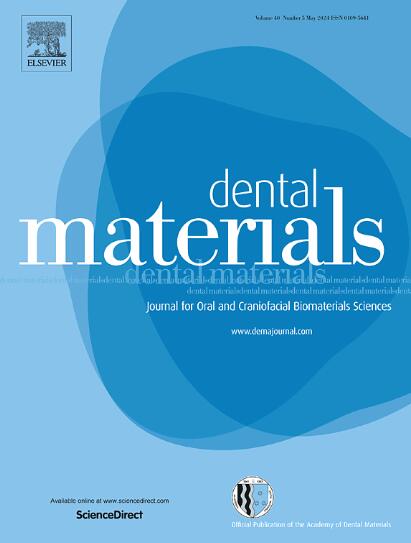Preparation of dental resin composites with anti-bacterial adhesion against Streptococcus mutans using fluorinated and silicon containing dimethacrylates
IF 6.3
1区 医学
Q1 DENTISTRY, ORAL SURGERY & MEDICINE
引用次数: 0
Abstract
Objective
The purpose of this study was to enhance the anti-bacterial adhesion effect against Streptococcus mutans (S. mutans) of fluorinated dimethacrylate (DF MA) based dental resin composites (DRCs) by using silicone dimethacrylate (SMA-MEO).
Method
The SMA-MEO was added into mixture of DFMA and tricyclo (5.2.1.0) decanedimethanol diacrylate (SR833s) (DFMA/SR833s = 50 wt./50 wt.) with mass ratios of 10 wt% and 20 wt% to form resin matrix both with fluorinated and silicon containing dimethacrylates, and then DRCs named DS+ 10 %SMA-MEO and DS+ 20 %SMA-MEO were prepared by mixing the resin matrix with silaned BaAlSiO2 filler particles at a mass ratio of 30 wt./70 wt. Double bond conversion, volumetric shrinkage and shrinkage stress, flexural strength and modulus, water sorption and solubility, contact angle and surface free energy, anti-bacterial adhesion effect against Streptococcus mutans (S. mutans), and cytotoxicity of prepared DRCs were investigated according to standard or referenced methods. Fluorinated dimethacrylate (DFMA) based DRC named DS and 2,2-bis[4-(2-hydroxy-3-methacryloy-loxypropyl)-phenyl]propane (Bis-GMA) based DRC named BT were used as controls.
Results
Adding SMA-MEO into DFMA based DRC could lead to higher double bond conversion (p < 0.05), higher hydrophobicity (p < 0.05), and lower surface free energy (p < 0.05). Only DS+ 10 %SMA-MEO had better anti-bacterial adhesion effect against S. mutans than DS (p < 0.05). The SMA-MEO had no influence on volumetric shrinkage, shrinkage stress, flexural modulus, water sorption and solubility of DRC (p > 0.05), but could reduce flexural strength of dry DRC (p < 0.05). After water immersion, SMA-MEO containing DRCs had comparable flexural strength as DS (p > 0.05). Compared with BT, DS and SMA-MEO containing DRCs had better or comparable physicochemical properties, and lower amount of adherent S. mutans. All of DRCs had comparable cytotoxicity (p > 0.05).
Significance
DRCs with both DFMA and SMA-MEO could have better anti-bacterial adhesion effect against S. mutans than DRC only with DFMA due to increased hydrophobicity and decreased Surface free energy, and the optimal mass fraction of SMA-MEO in DFMA based resin matrix was 10 wt%.
含氟二甲基丙烯酸酯和含硅二甲基丙烯酸酯制备对变形链球菌具有抗菌粘附作用的牙科树脂复合材料。
目的:采用硅氧烷二甲基丙烯酸酯(SMA-MEO)增强氟化二甲丙烯酸酯(DF MA)基牙科树脂复合材料(DRCs)对变形链球菌(S. mutans)的抗菌粘附作用。方法:DFMA SMA-MEO被添加到混合和tricyclo (5.2.1.0) decanedimethanol丙烯酸(SR833s)制成(DFMA / SR833s = 50 wt. / 50 wt。)与质量比10 wt % 20 wt %形式包含利用丙烯酸树脂矩阵与氟化和硅,然后刚果民主共和国命名DS + 10% SMA-MEO和DS + 20% SMA-MEO准备通过与硅烷混合树脂矩阵BaAlSiO2填料粒子的质量比30 wt. / 70 wt。双键转换,体积收缩和收缩应力,按照标准或参考方法考察制备的抗弯强度和模量、吸水性和溶解度、接触角和表面自由能、对变形链球菌(S. mutans)的抗菌粘附效果以及细胞毒性。以氟化二甲基丙烯酸酯(DFMA)基DRC命名为DS,以2,2-双[4-(2-羟基-3-甲基丙烯酸-氧基丙基)苯基]丙烷(Bis-GMA)基DRC命名为BT作为对照。结果:在DFMA基DRC中加入SMA-MEO可提高DRC的双键转化率(p < 0.05),但会降低DRC的抗弯强度(p < 0.05)。与BT相比,含有DRCs的DS和SMA-MEO具有更好或相当的物理化学性能,并且附着的变形链球菌数量较少。所有DRCs具有相当的细胞毒性(p < 0.05)。意义:与仅含有DFMA的DRC相比,含有DFMA和SMA-MEO的DRC对变形链球菌的抗菌粘附效果更好,这是由于其疏水性增加,表面自由能降低,而SMA-MEO在DFMA基树脂基体中的最佳质量分数为10 wt%。
本文章由计算机程序翻译,如有差异,请以英文原文为准。
求助全文
约1分钟内获得全文
求助全文
来源期刊

Dental Materials
工程技术-材料科学:生物材料
CiteScore
9.80
自引率
10.00%
发文量
290
审稿时长
67 days
期刊介绍:
Dental Materials publishes original research, review articles, and short communications.
Academy of Dental Materials members click here to register for free access to Dental Materials online.
The principal aim of Dental Materials is to promote rapid communication of scientific information between academia, industry, and the dental practitioner. Original Manuscripts on clinical and laboratory research of basic and applied character which focus on the properties or performance of dental materials or the reaction of host tissues to materials are given priority publication. Other acceptable topics include application technology in clinical dentistry and dental laboratory technology.
Comprehensive reviews and editorial commentaries on pertinent subjects will be considered.
 求助内容:
求助内容: 应助结果提醒方式:
应助结果提醒方式:


